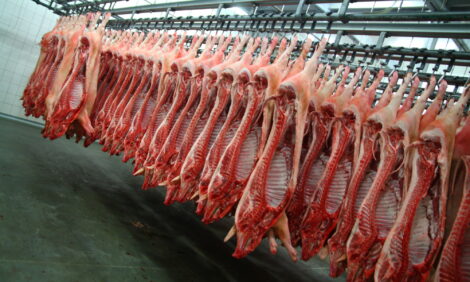



Nebraska Swine Report 2005 : Shoulder Ulcers in Sows and their prevention
By Duane E. Reese, Extension Swine Specialist, University of Nebraska; Barbara E. Straw, Extension Veterinarian, Michigan State University and Jess M. Waddell, Oklahoma State University and published by the University of Nebraska - A literature review was conducted on shoulder ulcers in sows. Shoulder ulcers are caused by pressure that the shoulder blade exerts against tissues that overlie it.
Shoulder Ulcers in Sows
Summary and Implications
Those tissues lose
blood supply and die. Because the
pressure is directed outward, tissue
damage occurs before the ulcer is
evident on the skin surface.
Ulcer
prevalence is highly variable; 0 to
more than 20% of the sows in 218
herds evaluated had shoulder ulcers.
Ulcers usually develop during late
gestation and early lactation and many
heal shortly after weaning. Numerous
risk factors for developing shoulder
ulcers have been identified.
Inactivity and thin sow body condition
seem to be the most important
ulcer risk factors. Thus, farrowing
caretakers may be able to prevent
ulcers by carefully monitoring each
sow’s lying behavior and attempting
to fix any problem that restricts movement.
Checking the gestation and
lactation feeding programs to ensure
that sows enter the farrowing area in
proper body condition also may prevent
ulcers. Experience from Denmark
indicates a pad fixed to the
shoulder of sows at the first sign of
redness in the skin may prevent
ulcers too.
Sows starting to develop
an ulcer benefit from treatment of
underlying issues that cause inactivity,
daily application of a topical
disinfectant, early weaning and movement
to a hospital pen, or a rubber
mat to lie on in the farrowing crate.
Close observation and appropriate
care of sows especially around the
time of farrowing should keep the
incidence of shoulder ulcers low in
the pork industry.
Introduction
Shoulder ulcers or pressure
sores in sows are becoming an
important issue in Denmark.
Danish slaughterhouses recently
begin pressuring pork producers
to reduce the number of sows
delivered to their plants that have
or have had shoulder ulcers. Shoulder
ulcers may be an indication of
sow welfare. Moreover, it is possible
that these sores may cause
sows to change positions frequently
in the crate to alleviate
pain, thus increasing the chances
of crushing piglets, according to
Iowa State University researchers.
Danish scientists suggest it’s
possible that open shoulder ulcers
predispose the sow to septicemia
or blood poisoning. The purpose
of this paper is to examine why
shoulder ulcers develop and what
producers can do about them.
Anatomy of the Shoulder
The shoulder blade or scapula
has a ridge (spine) running its
length that is the highest part of
the bone (Figure 1). In some sows
this spine is more pronounced than
in others. When the sow lies on
her side the bulk of her weight
presses down on her shoulder.
Because it sticks out the farthest,
the spine of the scapula bears the
most weight.
The pressure actually
comes from the weight of the
sow that presses downward, resting
on the point of the spine of the
scapula, much like the weight is
concentrated while wearing high
heels. Continual pressure on the
tissues overlying the scapula
restricts their blood supply and
eventually without blood, these
tissues die. Because the nerves that
supply the area also lose their
blood supply and die, the condition
is probably not painful.

Figure 1. Anatomy of the shoulder of a sow.

Figure 2. Shoulder ulcer on a sow.
Because the direction of the pressure is from inside out, most of the damage to the underlying tissue already has been done before it finally progresses to the skin (Figure 2).
Prevalence and timing of ulcer development
The prevalence of shoulder
ulcers in sows has been reported
by three groups of researchers. In
1996 North Carolina researchers
found 8.3% of the 1,916 females
of breeding age they examined
in a farrow-to-wean operation
had shoulder ulcers. In 2004
researchers in Denmark examined
570 lactating sows in 10 commercial
herds and reported 12% of
the sows had shoulder ulcers. In a
second Danish study involving 23,
794 sows from 207 sow herds,
about 70 herds reported only 5
percent or fewer of their sows had
shoulder ulcers while in about 15
herds there were 20% or more of
the sows with shoulder ulcers.
These results demonstrate that
significant variation in ulcer prevalence
exists in the pork industry.
The variation is likely related to
differences in production facilities
and management strategies.
The North Carolina researchers
determined that ulcer prevalence
was strongly associated with
time after farrowing. A year later
those researchers monitored lategestation
sows and gilts that did
not have shoulder ulcers on day 0
(when they were moved into farrowing
crates), and on days 5, 12,
18, 40, 54 and 68 thereafter.
Ulcers were observed on 33 of 206
shoulders (16%) by day 5. The
highest incidence of ulcers was
observed on day 12 (99 out of 206
shoulders; 48%). All the ulcers had
healed by day 68, although marked
healing was observed between day
12 and 18 while the sows were
still in the crates.
These results indicate that
shoulder ulcers develop rapidly
in early lactation and they can
begin to heal rapidly. Sows do lie
on their side a considerable amount
of time during parturition so it
makes sense most shoulder
ulcers would develop during early
lactation. In a previous study about
half of the sows did not shift the
side they were lying on while they
farrowed. Perhaps these sows are
most likely to develop shoulder
ulcers.
Risk factors associated with ulcers
The North Carolina scientists
used sow body condition, parity,
date of farrowing and litter size
born data in their analysis to
determine risk factors for shoulder
ulcers. In one Danish study
sows were examined visually for
body condition, hoof length, leg
disorders and skin integrity. The
overall cleanliness of the farrowing
area and sow parity and
lying-down behavior also were
assessed. In the second Danish
study a total of 33 potential risk
factors related to facilities and
management strategies were
evaluated. From these three studies
a list of key risk factors can be
compiled:
Prolonged recumbency or lying during parturition
Reduced activity in late gestation and early lactation
Post-farrowing illness
Sow body condition — thin sows have a greater ulcer risk
Sow body weight — heavier sows have a higher ulcer risk
Parity — ulcer prevalence increases with increased parity
Moist skin — increases ulcer prevalence
Duration of farrowing
Source of replacement gilts - using one’s own replacement gilts decreased ulcer prevalence
Hospital or sick pen — use decreased ulcer prevalence
Type of sow housing — confinement (stalled and tethered or tethered) increased ulcer prevalence
Number of caretakers in farrowing area — increased ulcer prevalence was observed with two caretakers compared to one
A topical disinfectant such as povidone iodine solution or wound dressing should be applied to the ulcer daily. If possible, wean the sow early and move her to a hospital pen to allow the ulcer to heal more rapidly.

Figure 3. A meaty or dry shoulder ulcer in a sow.
In general it is not necessary to administer injectable antibiotics to sows with shoulder ulcers that appear dry or “meaty” as shown in Figure 3. If the ulcer contains pus or if the sow runs a fever or goes off feed, an antibiotic, usually penicillin, should be given in addition to applying a topical disinfectant and trying to correct the reasons that the sow is lying down so much. After weaning the sow will take better care of herself and not spend so much time lying on her side and irritating the ulcer. If the sow cannot be weaned for a while, place a rubber mat in the farrowing crate to help distribute the pressure on the sow’s shoulder. Lay the mat on the floor so that when the sow is lying down her shoulders are on it.
Prevention
Studies indicate that many risk
factors are involved in the development
of shoulder ulcers in sows.
Some factors are not easy to
address. It’s clear that lack of animal
movement especially during
late gestation and early lactation
is an important factor in development
of shoulder ulcers. Thus, it
seems important for caretakers to
carefully monitor each sow’s
lying behavior and attempt to fix
any problem that restricts her
movement. Also, it might be useful
to get sows up soon after they
have finished farrowing to relieve
pressure on the tissues in the shoulder.
Sows that appear stained or
that have indentations of the flooring
design on one side probably
have been lying on that side for
some time. Providing these sows
a rubber mat to lie on probably
will prevent an ulcer from developing.
Ulcer risk is also higher in
thin sows so it is reasonable to
reevaluate the sow feeding program
during gestation and lactation
in an attempt to reduce the
number of thin sows that enter
the farrowing area. Don’t overfeed
sows in gestation, because
too much weight gain will cause
sows to be too heavy at farrowing
and therefore increase the risk of
shoulder ulcers.
If shoulder ulcers occur more
frequently during the summer and
drip cooling is being used in farrowing,
perhaps repositioning the
coolers over the sows’ heads or
reducing the drip rate might be
useful in reducing ulcer risk.

Figure 4. Shoulder pad fixed to a sow in Denmark.
Some producers in Denmark
are using a “Skulderpude” (shoulder
pad) to help prevent shoulder
ulcers (Figure 4). The pad is
strapped very firmly to the shoulder
of the sow using nylon straps
and Velcro. Thus, it is out of her
reach and piglets can’t destroy it.
It has foam padding on the inside
and a thick canvass material on
the exterior.
Producers are installing the
pads on sows as soon they
observe any redness of the skin
on the shoulder. The pads appear
to be relieving some of the pressure
that is placed against tissues
overlying the scapula and preventing
further damage. They fit
so tightly to the shoulder that it is
not advised to place them over an
open sore. Pads usually remain
on until sows are weaned. Then
they are washed and reused.
Further Information
To view the full list of Nebraska Swine Report 2005 articles, click here
Source: University of Nebraska, Lincoln - September 2005








